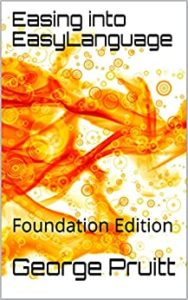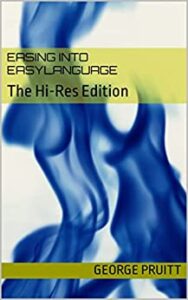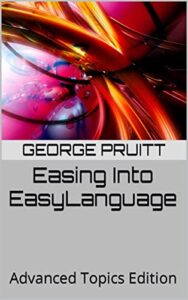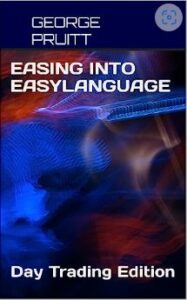Easing Into EasyLanguage – A New Series
The Series is Now Complete and Available at Amazon.com

The Foundation Edition
Hello to all EasyLanguage users! I have started a new series of books to help teach EasyLanguage. Here is the first book in the series – The Foundation Edition. You can find it here at Amazon.com – http://www.amzn.com/B09C2LSQ5P
You will need the password to download the ELD and workspaces.
The password is the last name of the person that is credited with quote in the chapter labeled EasyLanguage – What Is It?
Who said, “An algorithm must be seen to be believed.” Use his last name and remember the first letter must be capitalized.
Download here – Supplemental Material for The Foundation Edition.
This book is for beginners and for those you want to freshen up on their programming skills. The book includes 13 tutorials starting from the very basics of setting up a comfortable programming environment with the TDE and spans Strategies, ShowMes, PaintBars, and Functions. Pattern recognition is introduced as well as using Finite State Machines to help accomplish multiple step Analysis techniques. As a huge bonus there are over 4 hours of video instruction – one video per tutorial. All source code is downloadable via this site, as well as the workspaces. The series will progress from The Foundation Edition to more complicated programming ideas and data structures. The book will work with any platform that supports EasyLanguage, including MultiCharts.
Hurry and get your copy today! Once you buy the book go the page above and download the ELD and workspaces.
The HI-Res Edition
Correction and clarification – February 26, 2024
An astute reader of the Hi-Res edition has brought a couple of issues to my attention.
Correction: On page 20 of the paperback edition, I state the following incorrectly: “If you had two data on the chart and wanted to see the open time of data2 you would pass (0,2) to the sessionStartTime function.” This is a blunder on my part. I think I had recently worked on a multi-session chart for a client, which is different than a multi-data stream chart, and got this one confused. To get the open time of data2 you would simply ask TS to return the sessionStartTime(0,1) of data2.
Clarification: figuratively versus literally – on page 42 of the paperback edition. Tutorial 16 is where I discuss problems with holidays and shortened trading sessions. If you use @ES.D or any @##.D for data2 and a regular session for data1, you will find instances where data2 has a blank bar on a day that either closes early or doesn’t trade during the “DAY-SESSION.” In these cases, you will not have access, from Data2, the O-H-L-C for the shortened session. I say the following in the text which looks literal because I use bold for c of data2 and c[1] of data2 – “Since the daily close is carried over from the prior daily bar, c of data2 is the same as c[1] of data2.” I meant to imply that the stunted trading session’s close price is not recorded properly, so the close of data2 is figuratively c[1] of data2. I hope this makes sense. The c of data2 and c of data2 will never be literally equal. I provide a method to keep track of stunted trading sessions in this tutorial.
This is the second book in the series. With this book we have stepped on the accelarator in terms of complexity. Trading and Programming on intraday bars shifts to a whole new paradigm. In this book, I try to keep things as simple as possible but as you grow as a programmer so do the challenges. This book shows how to accurately measure the ebb and flow of the intraday market movement to determine accurate entry prices. Taking a daily bar system and throwing it against a five minute bar will not work as-is. Has your analysis been hindered by only programming systems where you don’t need to know what happens first in the trading day? Do you want to test a strategy that uses daily data to determine entry levels, but need to know if your long or short entry was entered first and if your position was stopped out before it took a profit or just the opposite. Strategies that can enter long AND short and/or uses tight stops and profit objectives require you to step through each bar of the trading day and make the RIGHT decisions. Can you rely on TradeStation’s LOOK INSIDE BAR capability 100%? The answer is no – especially if you are thinking about automation. Get your copy today and learn from ten tutorials and over 5 hours of video instruction.
Learn how to day trade using volatility, the enigmatic Camarilla indicator, and complicated pattern recognition.
Here is the download webpage. Remember you will need the password which is divulged in the Introduction to the Hi-Res Edition.
The Advanced Topics Edition
This is the third book in the series. This is not a beginner’s book, but one that will use your knowledge, either from experience or from reading The Foundation and Hi-Res editions of Easing Into EasyLanguage, to tackle some really neat ideas and concepts. The first two books were designed to teach the basics of EasyLanguage through two different paradigms: daily and intra day. In this book there is a tutorial on the Commitment of Traders report that uses very specific EasyLanguage code. This specific code will not work with MultiCharts. I apologize for this up front, but advanced topics need advanced programming techniques. I will let you know at the beginning of each tutorial if it is pure EasyLanguage or not. This book will treat EasyLanguage like an actual programming language and use it to tackle some interesting and practical algorithms. This book does not introduce the OOEL library (object version of EasyLanguage) because that would be too much of a leap from The Foundation Edition. However, do not worry because we will cover some pretty hairy stuff.
Advanced Topics could cover a vast amount of ideas and concepts and be the length of “War and Peace” on steroids. Since this book is part of the series, I wanted to cover a handful of concepts that included the follow programming constructs:
- Arrays and their manipulation
- Buffers – fixed length arrays
- tools to maintain N elements
- formulas and methods for extracting and sorting data
- Finite State Machines
- switch-case construct
- range based case values
- Original Text Graphic Objects
- retrieving text object and evaluating its contents
- determining X and Y coordinate values of text location
- Seasonality
- The Murray Ruggiero and Mike Barna Universal Seasonal
- Indicator
- Strategy
- Sheldon Knight Universal Seasonal
- Indicator
- Strategy
- The Murray Ruggiero and Mike Barna Universal Seasonal
- Introduction to EasyLanguage’s Project Concept
- Steps to create a Project
- Adding/Deleting files from Project
- Saving and Exporting Project
- Utilizing TradeStation’s FundValue functionality
- Downloading the Commitment Of Traders Data
- Utilizing the COT data in a strategy
- Combining weekly report data with daily bars
- Programming a Multi-Time Frame indicator
- Inserting multiple time frames into a single chart
- Elaborate discussion on the key concept of Data Aliasing
- Including Day Of Month Seasonal Analysis
- Tools to help determine day of month on chart
Here is the link to the supplemental material. Remember you will need the password – it is in the front matter of the book.
Link to ELD, ELP, TSW and text files of source code.
The Day Trade Edition
The Easing Into EasyLanguage series was supposed to stop at the
Advanced Topics Edition. But the more I thought about it, a book
solely dedicated to programming day trading systems was an
absolute necessity. This book is really the child of my Hi-Res
Edition; several topics are covered in both books and even some
of the code will look similar. However, this book is dedicated
to getting in and out in the same day, period. There are close
to two hundred pages of strictly daytrading ideas, analysis and
code. You may ask yourself, “Do I need to read the Hi-Res Edition
first?” before tackling this latest installment. I would answer it
couldn’t hurt, but it is not absolutely necessary. I hope you enjoy
this latest book, and I can’t promise I am finished adding more books to the series. The following concepts for entering trades on a day trade basis are discussed:
- Open Range Break Out – these strategies us momentum and time to determine entry levels.
- Volatility Based Break Out – volatility is used to determine if and when and where entry signals are placed.
- Pyramania – multiple positions are added as the market moves through different levels. All the trade accounting for each position is discussed and coded. Do you want to learn how to program this?
- Camarilla – learn how to program entries and exits from the enigmatic equation. Pyramiding is utilized in break out and mean reversion schemes.
- Put X on and Peel Y – learn how to place initial multiple units and then scale out of a portion of initial position at a loss or at a profit. Learn how to make a trade a free trade.
- Break Out and Clear Out – two strong forces working as one in a strategy.
- modify stop levels based on profit
- program you own break-even trade
- program you own ratcheting stop
- Optimize across different time spans and perform day of week (DOW) analysis.
I have included workspaces for both TS 10.0 and 9.5. I have also taken screen shots of all workspaces to easily recreate in Multi-Charts.
Once you purchase the book – go to the download page to get all of the supplemental material.
DayTrading Edition | George Pruitt
The Trend Following Edition
October 2024 Update – Get six hours of video tutorial. These strategies involve some esoteric code and a little trickery, so I created 10 videos each lasting around 30 minutes to help explain the codes of these fascinating algorithms.
I know I keep adding books to the series, but the more I thought about it, a book solely dedicated to programming trend following systems and discussing the legends I worked with for over 30 years was another absolute necessity. This book could easily follow The Foundation Edition, as the code is easier to understand since we are solely working with daily bars. This book will teach EasyLanguage through complete trading system examples. I have gleaned an encyclopedia of Trend Following from knowledge from those who I consider legends of the industry
- Keith Ftischen
- Randy Stuckey
- Murray Ruggiero
- Peter Waite
- Dave Fox
- Michael Chisholm
- Andreas Clenow
- Bruce Babcock
- John Hill
- Micheal Covel
For thirty-one years, I served as the Director of Research at Futures Truth Magazine. During this time, I had the great pleasure of working with some of the brightest minds in technical analysis. I learned from their expertise and witnessed firsthand how their trend-following techniques soared to great heights, only to plummet and eventually rise again. From late 2014 to early 2020, I observed the entire trend-following industry collapse. Systems such as Aberration, CatScan, Andromeda, Super Turtle, and many others that had thrived on the high-flying trends of the 1990s, 2000s, and early 2010s, faded away well before the onset of the pandemic.
For many years, trend followers were the darlings of numerous futures fund managers, who once controlled billions. However, since the pandemic, we have seen many of these systems rise from the ashes like a Phoenix. The long-awaited increase in commodity prices finally arrived as the world began to shut down. This prolonged period of stagnation outlasted many fund managers’ ability to endure; incentive fees went unpaid for years. With no downturn to hedge against, many turned to simply buying and holding tech stocks. Commodities, being limited resources like oil, corn, beans, and gold, were expected to rise in price eventually. This belief sustained us as we wandered in the wilderness after the last boom in 2014.
It took a major global disaster to finally stir prices and pressure the stock market. The raging bull market that had trampled hedge fund managers for years began to show signs of weakness. However, this weakness was short-lived as the post-pandemic reopening and the artificial intelligence boom propelled the stock market to all-time highs. The recession that many experts predicted has yet to materialize, even as we grapple with heightened inflation. We are continually confronted with conflicting and evolving views on the future of our economy. Could this period of flux usher in the type of markets that can be harnessed by the trend-following techniques of the ’90s?
Learn how to program the most popular Trend Following Entry and Exit Techniques and Trade Management from scratch.
- EasyLanguage code for twelve very popular Trend Following algorithms
- Support code in the form of functions:
- Choppy market indicators
- Ehlers smoothing functions
- Bollinger, Keltner and Donchian indicators
- Volatility dampening
- Support code in the form of functions:
- Systems from books such Clenow, Covel, Fitschen and Babcock.
- Systems similar to the high fliers of the 1990s, 2000s and early 2010s.
- Is Donchian better than Bollinger? Is Bollinger better than Keltner?
- Learn the best parameters for each entry/exit technique.
- What makes these system work and fail?
- Should the parameters adapt to the current market environment?
- Use John Ehler’s smoothing techniques to super charge the Turtle Algorithm
- Were Dennis and Eckhardt on the right track? Or were they a product of the times?
- Learn some of the more popular Turtle Trading Techniques
- Last trade was a Loser Filter
- Fixed Fractional allocation
- Pyramid as market moves in direction of trade
- Learn some of the more popular Turtle Trading Techniques
Enhance your programming knowledge while learning the intricacies of creating a reliable trend-following algorithm. Well at least in my opinion. Supplemental material includes TradeStation and MultiCharts files.






